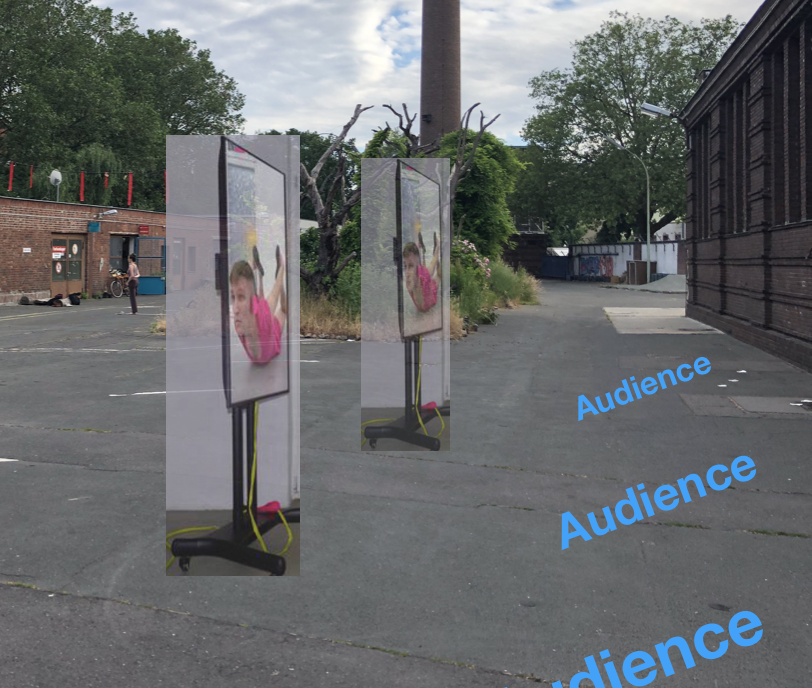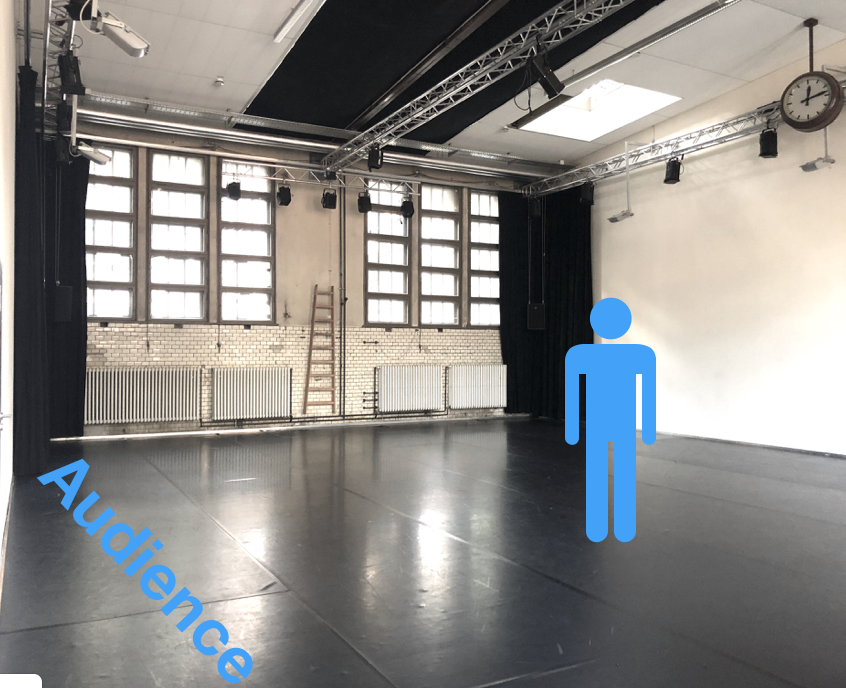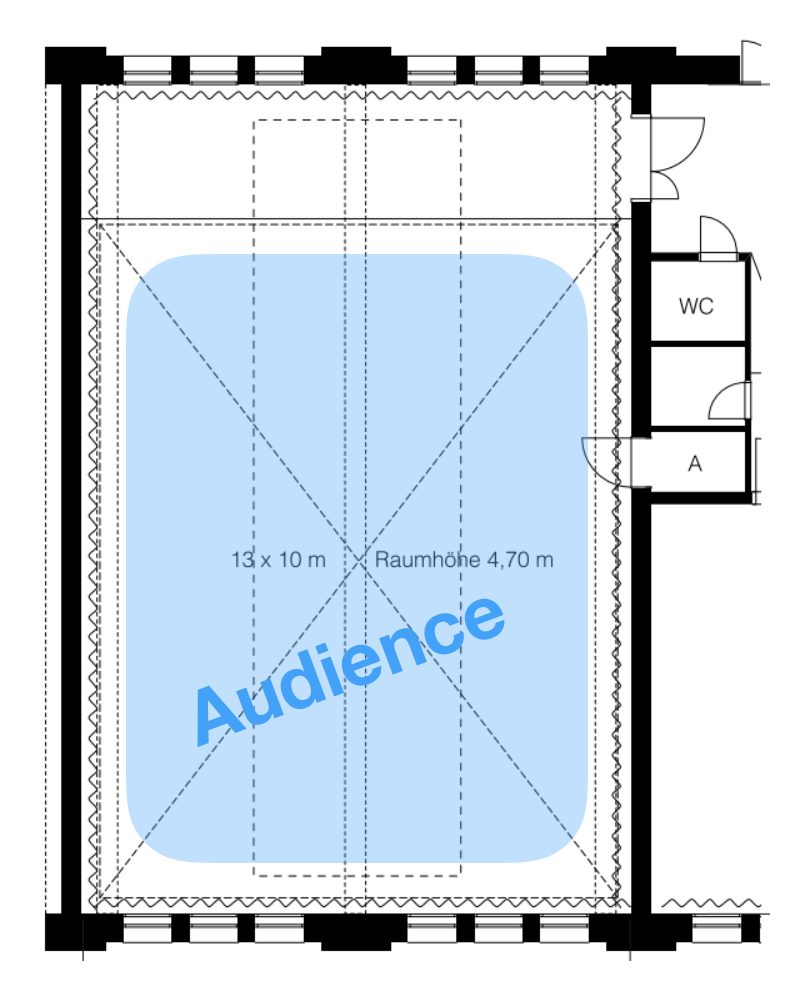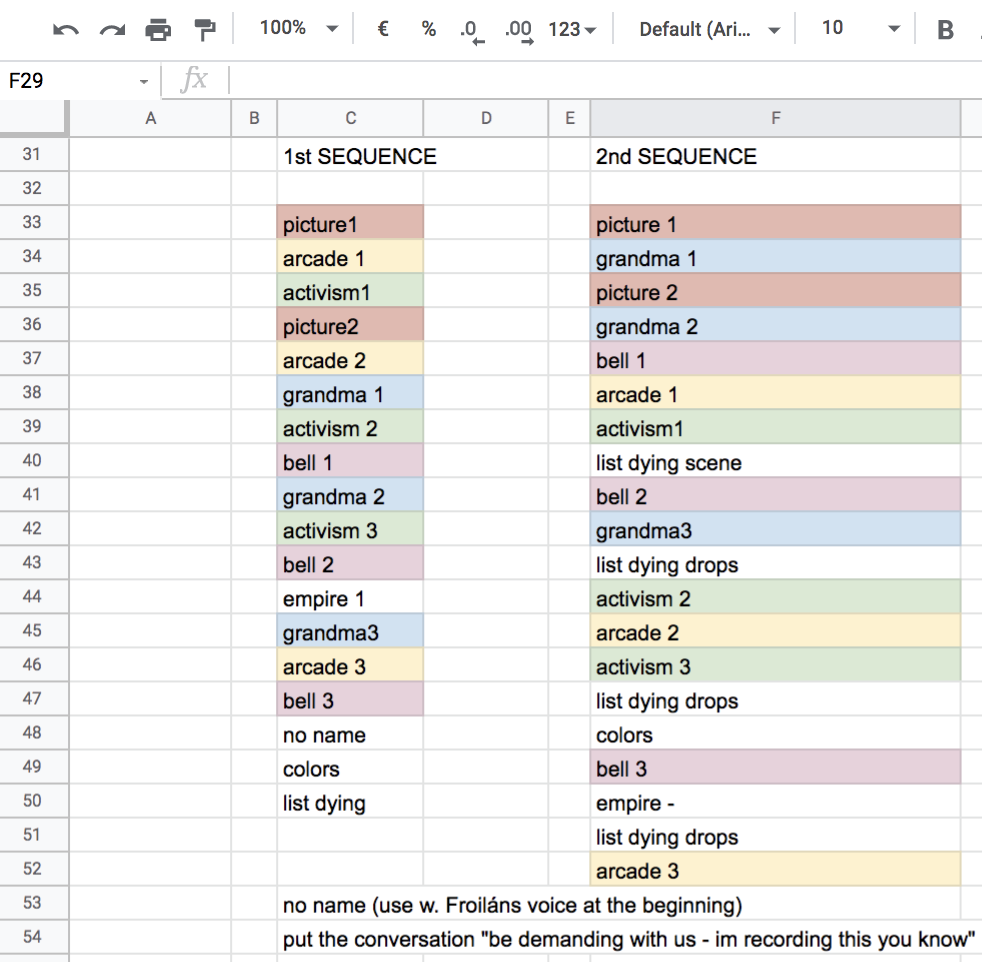BRUNO AND I
WORKBOOK_301
OCTOBER_2021
BERNARDO DE ALMEIDA
UDK_HZT_SODA
STUDENT ID_372035
Coming from previous SODA episodes,
quick catch up:
I'm keeping my interest in storytelling.
Departing from concrete biographical episodes in an evolution to fictional layers.
The usage of different stations that contribute to the unfolding of a common narrative.
The practice of repetition in the composition and transformation of materials.
The usage of video and voice over along with live performance.
I'm still collaborating with Bruno Huca,
invited guest performer in prior module 201.
I’ve started this 301 module with the research question:
How to construct a script for a narrative to be explored in different mediums and different spatial configurations, within the same presentation event.
The presentation is proposed in 3 stations, in sequence, one following another.
The usage of different mediums in a performance work is a common practice in art history. But mainly the mediums being used in an overlapping context.
My proposal in this module is to experiment with a set of rules that clarify a main medium for each station, and the languages of communication to be used through each medium, as the support to unfold a narrative through the 3 stations.
A narrative that is molded by a positive dependency on the chosen mediums and languages, as each medium constrains and specifies the way the information can be communicated. The mediums have different potentials and impacts on the spatial dimension, temporal dimension, and specific ways to trigger the spectators’ imaginary.
So, a fast framing on structure would be:
Station 1 - an audio installation - usage of recorded verbal language of two performers; no live performer.
Station 2 - a video installation - usage of video presenting two bodies; no verbal language and no live performer.
Station 3 - live performance, only Bernardo as a live performer.
I’m proposing that the audience move in between the stations, as the different mediums can also encourage different spatial relations with the spectators. The audience movement also reinforces the transitions between the stations, provoking in the spectator a different body availability on relating and digesting the given information.
I’m designing a plan B, to be activated by reasons of weather or technical conditions, so all the 3 stations would work inside studio 9.
Why Bruno ?
One of my main ideas when applying to SODA was to explore an artistic translation of my concerns related with the Portuguese systemic denial of History, and lack of collective awareness of contemporary (worldwide) colonial consequences.
In my life, this concern only really started to spark when I met Bruno 18 years ago. We were 18 at that time.
So on prior module 201 I’ve decided to invite Bruno to collaborate with me, as a true and strong biographical milestone on this matter, plus the fact that Bruno is a fellow artist with whom I can discuss openly and productively.
Now, for the 301, the topic of colonialism is inevitably present, as being part of our major life concerns, but it isn't here a subject to be pursued as a goal, nor as a conductive line of the proposed narrative.
Along with my conceptual experiments on different mediums and languages, this time I invited Bruno to unfold with me a narrative about love, the practice of love, even in loss and absence.



station 1- sound installation
set in studio 9
station 2 - video installation
set in the yard
station 3 - live performance
set again inside studio 9.
By looking back to our lives together, and our individual paths and backgrounds, with both common and very contrasting life configurations, I wanted to find relatable places of meaning, not avoiding ethical questions that may arise while exposing some episodes of our biographies, but precisely the will to be available to face them, to play with them, and open them up to a broader range.
How to make biographical episodes interesting to someone to witness, when does it get relevant for someone to engage with it ?
How to project Bruno and I beyond the two of us ?
How to have a strong subtextual layer, exploring the level of the “things that have no name”. I call “things that have no name” to the tuned and delicate communicational (energetical, existential) bond between two very intimate people - how to make this layer somehow visible or visitable to the audience?
Set of rules:
As a starting point to brainstorm and script the narrative, I tried to design a set of rules that would define evolutions from station 1 to station 3, for example:
From biographical to fictional, to metaphorical;
From body closeness to absence;
From a faster pace in the narrative unfolding, to a slower tempo, even symbolic.
Station 1 - more biographical, believable, the two voices/bodies are always intimate, close and together. A lot of concrete information is given in a fast pace to contextualize what relationship they might have, or might have had.
Station 2 - more fictional, poetic, without losing the quality of real gestures or daily life, from the prior station. The closeness of the bodies start to get apart from one another. Slower tempo on the way the information is given. Shorter narrative evolution.
Station 3 - more metaphorical, bodies separated, absence. Diffuse narrative evolution.
I met Luanda after watching her performance Killjoy Quiz, during our excursion to the Festival Theaterformen in Hannover last July.
Since then we’ve been in dialogue about narratology concepts and storytelling.
She referenced and provided to me some texts that influenced my research and brainstorming.
Luanda is a performer and director, with a teaching position at the KASK conservatory in Ghent.
At the end of her performance, each audience member, when leaving the venue, was given a book edition of Killjoy Quiz. On a first impact, it seemed to be the script of the performance we had just seen. But later at night I realized that not only was it the script, but it had more content. On several occasions the book opened and developed threads that weren’t shown or explored in the live performance, so complementing and unfolding it. I immediately related it with my intentions with exploring different mediums for a common narrative, as I precisely enjoyed the book as a different medium, that transported the imaginary I had already created while watching the performance to other layers of meaning and content.
PREVIOUS
HERE AND NOW
DRAMATURGY
Spatio-temporal dimensions
The exercise of transitioning mediums and consequent change of how information is given to the spectators is also being explored to create spatial and temporal confusion. Both in the location and chronology of events, as in the quality of how time passes. The story through the 3 stations is meant to be blurry, without losing the narrative thread.
A sound installation of two people talking with each other.
How does the installation trigger the spectators imagination?
As the spectators here only listen to a combination of conversations, they are impelled to imagine, from their subjective life experience, two bodies for those two voices, as well as to imagine their possible locations.
(ideally from the perspective of a spectator that would not know Bernardo and Bruno personally, so not recognizing their voices)
I used the same strategy of open script explored in my video with Bruno in module 201. A script as a structure of knowing precisely what do we want to talk about, what turning points we want to make and where we want to reach, while all the conversation is meant to be improvised - not memorised, nor read.
We studied and discussed thoroughly, in advance, that precise and structured open script before recording.
My surprise when I discussed this experience with Luanda and she told me that the book was made because she just wasn't able to fit all she wanted to say inside the performance she had scripted during 3 years along with a fellow dramaturg.
So they just decided to publish the script as an uncut version.
We laughed.
LUANDA CASELLA
Spontaneously occurring natural narrative:
I meant to explore this nature, of having excerpts of conversations between Bruno and Bernardo in a believable tone, recreating and playing with possible conversations of our daily life together, with the quality of a naturally occurring story. The conversational narrative in storytelling is the quality of a short story/episode, or meaningful excerpt, that apparently emerges from within a larger conversation, that might not even have a clear beginning nor end, nor concrete context. But the content of the episode or excerpt shown is meant to be clear.
“(...) spontaneous conversational narrative. This covers narratives produced in face-to-face exchanges in a variety of contexts such as storytelling sequences at dinner parties, brief narratives interspersed in telephone conversations or in doctor/patient and lawyer/client exchanges. (...) emphasizing the fact that conversational narrative occurs in the framework of everyday interaction. Spontaneous (or unsolicited) conversational narrative must be distinguished from solicited narratives told to interviewers.”
Monika Fludernik
in Conversational Narration – Oral Narration https://www.lhn.uni-hamburg.de/node/34.html
The instrument of repetition is used in this station in the way the excerpts of dialogues are intertwined, non chronologically.
Sometimes the repetition comes only with a development, sometimes it has a shift in the narrative heard before.
This is meant to trigger the exercise of comparison and expectation over the feeling of repetition and how it unfolds new information.
The structural fakeness is assumed.
We are two actors recording inside a studio, playing on being credible.
STATION 1
audio excerpt
recording takes;
mapping process
and intertwining of the different conversations
At this phase of the work, I'm mainly busy with this station, dealing with several dramaturgical questions:
How do I present Bernardo in the absence of Bruno’s body?
How to work with Bruno's absence and potential death without being too much dramatic?
How near do I start from the information left on the last station? What links to use?
How to be symbolic without narrowing the narrative to an end?
How can the melancholic arch from the prior station be even twisted into a comic layer?
How can I work the editing of time and space in a live performance?
How to do a close-up on a detail, inside a broader looping exercise of a certain action/ movement?
A video installation. A diptico composed of two vertical screens.
How does the installation trigger the spectators imagination?
Verbal language speaks to the mind rather than to the senses, but now, after a conversational landscape, the change of medium proposes a completely different way on how the spectators relate with and absorb the information. The most (ab)used sense of the human body is asked to be activated.
The images present two bodies in four different storyworlds, with basically no sound.
In this installation, spectators can follow, deduce, speculate about the evolution of the relationship of Bruno and Bernardo, through the visual input of two bodies that only communicate through touch, gesture, action and movement.

"Cognitive science may tell us that not all thinking is verbal, but the translation of private thought into language is one of the most powerful and widespread narrative devices"
Marie-Laure Ryan
in Narration in Various Media
https://www.lhn.uni-hamburg.de/node/53.html
How to relate with the information of the prior station, without the temptation of explaining it?
The language in the images is more poetical, while still exploring the quality of bodies in daily gestures.
A slower use of time is important here.
Silence is important too.
Contrasting with the amount of information that had to be digested from the prior station, now being projected into these visualized bodies.
a melancholic atmosphere is installed.
An invisible link is the “Things that have no name”, the last conversation heard in the prior station. The evolution of these bodies on getting apart from each other is an attempt to translate something that doesn’t fit into words.
There is a dreamy layer, and some existential mood being explored through movement by Bruno’s body.
There is a further possibility of absence, trying not to be an explicit or unique way to be read.
The instrument of repetition is used in this station in several ways:
The usage of two vertical screens stimulate parallel possibilities, as different viewpoints over the same moment, or shifting narratives of the same moment; exercises of comparison and resemblance, creating expectation about chronology; the possibility of images as being someone's memory.
How to dance with the editing?
The rhythm generated in the narrative is based on different ways of relating the two parallel images. Sometimes the content is complementing/ contributing to each other. Sometimes it is competing, stealing attention from one another. Sometimes one image is left alone, to breathe for a while.
There are patterns comfortably installed at the beginning, like both screens changing the storyworld at the same time, or each screen presenting only one respective body. These patterns are smoothly broken throughout the editing.
A live performance
The main focus of this station is the change to a medium that cannot use the power of editing as in the prior two stations, inevitably exploring the quality of the here and now.
While in the prior two stations there was a lot of playfulness over chronological time and location, now, my present body in the studio determines a real action in real time.
Repetition is used to compose the movement of the body in space.
recording takes;
mapping process
of one storyworld
storyboards;
1st
sequence tryout
Fróilan Urzagasti
my sound and video collaborator
notebook
STATION 2
video excerpt
editing version
“(...) other new research area focuses on the spreading of narrative content across multiple media platforms. Widely known as “transmedia” or “transmedial” narration (…) the phenomenon of transmedial storytelling raises important theoretical questions, such as: are the component of the system autonomous, or do they presuppose knowledge of other members of the network; how do the storyworlds of the various texts relate to each other;
what elements must be present for audiences to assume that, despite additions or modifications, texts of different media refer to the same storyworld; and what kind of stories inspire transmedial developments.”
Marie-Laure Ryan
in Narration in Various Media
https://www.lhn.uni-hamburg.de/node/53.html
STATION 3
--------------> scroll horizontally -------------->